| Weight | 1 lbs |
|---|---|
| Dimensions | 9 × 5 × 2 in |
| host | mouse |
| isotype | IgG2b |
| clonality | monoclonal |
| concentration | concentrate, predilute |
| applications | IHC |
| reactivity | human |
| available size | 0.1 mL, 0.5 mL, 1 mL concentrated, 7 mL prediluted |
mouse anti-OCT-4 monoclonal antibody (C-10) 6300
Price range: $160.00 through $528.00
Antibody summary
- Mouse monoclonal to OCT-4
- Suitable for: Immunohistochemistry (formalin-fixed, paraffin-embedded tissues)
- Reacts with: Human
- Isotype:IgG2b
- Control: Seminoma
- Visualization: Nuclear
- 0.1, 0.5, 1.0 mL concentrated, 7 mL prediluted
mouse anti-OCT-4 monoclonal antibody C-10 6300
| target relevance |
|---|
| Protein names POU domain, class 5, transcription factor 1 (Octamer-binding protein 3) (Oct-3) (Octamer-binding protein 4) (Oct-4) (Octamer-binding transcription factor 3) (OTF-3) |
| Gene names POU5F1,POU5F1 OCT3 OCT4 OTF3 |
| Protein family POU transcription factor family, Class-5 subfamily |
| Mass 38571Da |
| Function FUNCTION: Transcription factor that binds to the octamer motif (5'-ATTTGCAT-3'). Forms a trimeric complex with SOX2 or SOX15 on DNA and controls the expression of a number of genes involved in embryonic development such as YES1, FGF4, UTF1 and ZFP206. Critical for early embryogenesis and for embryonic stem cell pluripotency. {ECO:0000269|PubMed:18035408}. |
| Subellular location SUBCELLULAR LOCATION: Cytoplasm. Nucleus. Note=Expressed in a diffuse and slightly punctuate pattern. Colocalizes with MAPK8 and MAPK9 in the nucleus. {ECO:0000250|UniProtKB:P20263, ECO:0000269|PubMed:18191611, ECO:0000269|PubMed:19274063, ECO:0000269|PubMed:23024368}. |
| Tissues TISSUE SPECIFICITY: Expressed in developing brain. Highest levels found in specific cell layers of the cortex, the olfactory bulb, the hippocampus and the cerebellum. Low levels of expression in adult tissues. {ECO:0000269|PubMed:1408763, ECO:0000269|PubMed:7908264}. |
| Structure SUBUNIT: Interacts with PKM. Interacts with WWP2. Interacts with UBE2I and ZSCAN10 (By similarity). Interacts with PCGF1 (PubMed:26687479). Interacts with ESRRB; recruits ESRRB near the POU5F1-SOX2 element in the NANOG proximal promoter; the interaction is DNA independent (By similarity). Interacts with ZNF322 (By similarity). Interacts with MAPK8 and MAPK9; the interaction allows MAPK8 and MAPK9 to phosphorylate POU5F1 on Ser-355 (By similarity). Interacts (when phosphorylated on Ser-355) with FBXW8 (By similarity). Interacts with FBXW4 (By similarity). Interacts with SOX2 and SOX15; binds synergistically with either SOX2 or SOX15 to DNA (By similarity). Interacts with DDX56 (By similarity). {ECO:0000250|UniProtKB:P20263, ECO:0000269|PubMed:18191611, ECO:0000269|PubMed:19274063, ECO:0000269|PubMed:26687479}. |
| Post-translational modification PTM: Sumoylation enhances the protein stability, DNA binding and transactivation activity. Sumoylation is required for enhanced YES1 expression. {ECO:0000250|UniProtKB:P20263}.; PTM: Ubiquitinated; undergoes 'Lys-63'-linked polyubiquitination by WWP2 leading to proteasomal degradation. {ECO:0000250|UniProtKB:P20263}.; PTM: ERK1/2-mediated phosphorylation at Ser-111 promotes nuclear exclusion and proteasomal degradation. Phosphorylation at Thr-235 and Ser-236 decrease DNA-binding and alters ability to activate transcription. {ECO:0000269|PubMed:22474382, ECO:0000269|PubMed:23024368}. |
| Domain DOMAIN: The POU-specific domain mediates interaction with PKM. {ECO:0000269|PubMed:18191611}.; DOMAIN: The 9aaTAD motif is a transactivation domain present in a large number of yeast and animal transcription factors. {ECO:0000269|PubMed:34342803}. |
| Biotechnology BIOTECHNOLOGY: POU5F1/OCT4, SOX2, MYC/c-Myc and KLF4 are the four Yamanaka factors. When combined, these factors are sufficient to reprogram differentiated cells to an embryonic-like state designated iPS (induced pluripotent stem) cells. iPS cells exhibit the morphology and growth properties of ES cells and express ES cell marker genes. {ECO:0000269|PubMed:18035408}. |
| Target Relevance information above includes information from UniProt accession: Q01860 |
| The UniProt Consortium |
Data
 |
| Human seminoma stained with anti-OCT-4 antibody using peroxidase-conjugate and DAB chromogen. Note the nuclear staining of seminoma cells. |
Publications
| pmid | title | authors | citation |
|---|---|---|---|
| We haven't added any publications to our database yet. | |||
Protocols
| relevant to this product |
|---|
| IHC |
Documents
| # | SDS | Certificate | |
|---|---|---|---|
| Please enter your product and batch number here to retrieve product datasheet, SDS, and QC information. | |||
Only logged in customers who have purchased this product may leave a review.

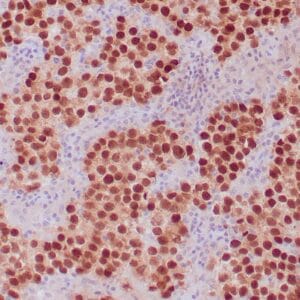
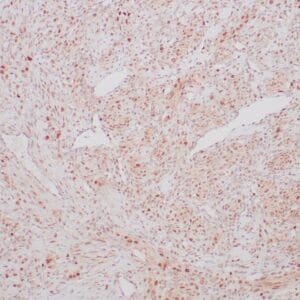
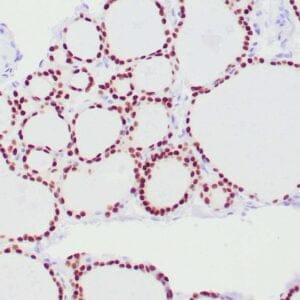


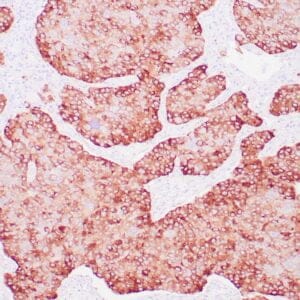




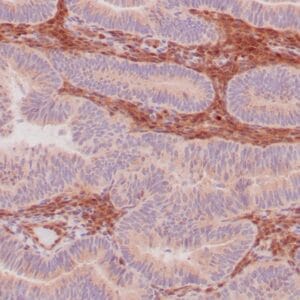
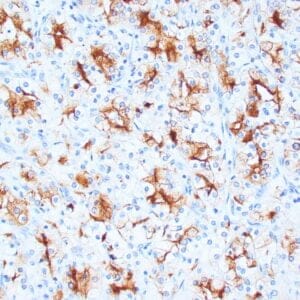

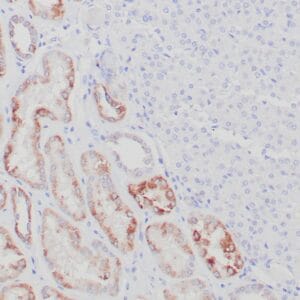
Reviews
There are no reviews yet.